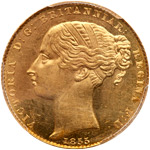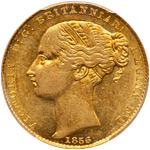
|
Sale 122
June 13-16 Pre-Long Beach Auction
| Treasure from the SS Central America - World Gold |
| |
| |
| Lot |
Photo |
Description |
Realized |
Lot 1675 |
 |
Australia. Sovereign, 1855 (Sydney). Fr-9; KM-2. Victoria. Filleted young head left. Reverse; Crown above AUSTRALIA within wreath. Rarest date of a two year type. Extremely Rare in Mint State. PCGS: SS Central America Pop 1, none finer; Regular: Pop 1; 2 finer, 1 in 63, 1 in 64. PCGS graded MS-62+. In special PCGS Ship of Gold holder which contains One Pinch of Gold Dust recovered from the S.S. Central America treasure.
Special PCGS number 670835.62+/34510971. Estimated Value $25,000 - UP
In the early 1850s Australia experienced several major gold rushes in the colonies of Victoria, New South Wales, South Australia, and Van Diemen's Land (Tasmania), some of which almost certainly provided the bullion for this gold sovereign struck at the Sydney mint in New South Wales. Although Sydney had petitioned the British Government for its own branch mint already in 1851, this was only approved by Queen Victoria in 1853. The new Sydney Mint was established in the south wing of the city's Rum Hospital for convicts-so called because it was built in 1810-1816 with the financial assistance of a consortium of businessmen who were granted a monopoly on rum imports. Before it became the mint, the south wing had largely served as surgeons' quarters and a temporary military hospital.
The present coin, struck in 1855, represents the very first official gold coin struck in Australia. The Adelaide Pound had been struck already by the Government Assay Office of South Australia in 1852, but this was a regional response to the lack of gold coin in the colony undertaken without the approval of the British Government. The 1855 gold sovereign is remarkable not only for marking the beginning of gold coin production at the Sydney mint, but for several features of its design. The reverse is notable for its prominent use of the full name of the mint (usually abbreviated on issues of other British colonial mints) and especially for the legend naming Australia rather than New South Wales. This would seem to indicate that the coinage was intended for use throughout Australia and not just within the colony in which it was produced. At the time, this was very forward thinking since the Australian colonies did not become united under a single government until the Federation of Australia on 1 January 1901.
Interestingly, in the same year that the first sovereigns of the Sydney mint entered production, fallout from earlier problems with the Australian gold rushes were being settled. In 1854, tensions had risen in the Victoria gold fields over the high cost of government mining licenses, which amounted to taxation without representation. This resulted in the Eureka Rebellion in Ballaarat, Victoria, in which 500 miners led by Peter Lalor, opposed colonial authorities from behind a makeshift stockade. The stockade was besieged and taken by elements of the British Army and the Victoria Police on 3 December 1854 and the rebels arrested. They were placed on trial for high treason in Melbourne in February 1855, but found not guilty by the jury, which largely supported their views. Peter Lalor was subsequently elected without opposition to the Victorian Legislative Council in November 1855.
View details and enlarged photos
Realized
$55,200 |
|
Lot 1676 |
 |
Australia. Sovereign, 1856 (Sydney). Fr-9; KM-2. Victoria. Filleted young head left. Reverse; Crown above AUSTRALIA within wreath. Two year type. Rare in top grades. PCGS: SS Central America Pop 1, none finer; Regular: Pop 4; 2 finer, 1 in 58+, 1 in 62. PCGS graded AU-58. In special PCGS Ship of Gold holder which contains One Pinch of Gold Dust recovered from the S.S. Central America treasure.
Special PCGS number 670836.58/34510972. Estimated Value $12,500 - UP
The 1856 Australian gold sovereign was struck in the second year of operation of the Sydney mint, which saw production almost double what it had been in 1855. Nevertheless, high grade sovereigns of 1856 are now at least as rare as the initial 1855 issue. The 1856 sovereign is notable as the last issue struck by the Sydney mint before the portrait of Queen Victoria was redesigned with some extra local flavor. Whereas the 1855-1856 portrait (Type 1) is closely modeled on British prototypes, in 1857 a new portrait (Type 2) was introduced which included a sprig of banksia (a wildflower indigenous to Australia) in the queen's hair. This modification was overlooked by the British Government until 1871, when approval for the design was revoked and the Sydney mint reverted to the more traditional British portrait type.
The year 1856 was pivotal for the development of democratic institutions in the colonies of Australia, which served as a precursor to the political changes and movements resulting in the Federation of Australia in 1901. In this year, Tasmania (7 February), Victoria (19 March), and New South Wales (2 April) all introduced new laws requiring the use of the secret ballot for elections. This was a dramatic political development considering that the only modern state to adopt the secret ballot previously had been Revolutionary France in 1795 (reaffirmed in the republican constitution of 1848). The institution of the secret ballot by these Australian colonies was so remarkable for the period that when the system was adopted by the individual states of the United States over the course of 1884-1891 it was widely known as the "Australian Ballot."
At the same time that the colonies of Australia were beginning to chart their future as democratic responsible governments, in 1856 the unsavory penal history of Australia began to be erased. After the transportation of convicts to New South Wales was suspended in 1824, Van Diemen's Land became the primary Australian penal colony-a dubious status that it retained until 1853, when convicts ceased to be transported there as part of their sentence. With an end to criminal transportation, Van Diemen's Land became a Crown colony, but its inhabitants (known in Australia as "Vandemonians") suffered discrimination as a result of the penal past. Following a successful petition to the British Government, in 1856 Van Diemen's Land was renamed Tasmania in an attempt to remove the stigma of the old penal colony. In 1642 Van Diemen's Land had been named in honor of Antonio van Diemen, the Governor-General of the Dutch East Indies (1636-1645), but in 1856 it was renamed Tasmania in honor of Abel Tasman, the Dutch explorer who became the first European to land on the island (1642).
View details and enlarged photos
Realized
$31,200 |
|
|
|